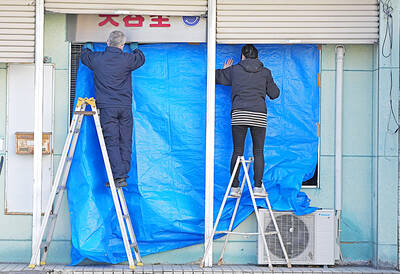It was supposed to be one of southern Taiwan’s most ambitious building projects in years, a defining NT$6 billion (US$189 million) world-class museum that promised stunning modern architecture, storing tens of thousands of rare antique works of art and ancient treasures from throughout Asia.
Nearly a decade since it was first announced, Paul Fehlau, an executive senior associate at US-based Antoine Predock Architect (APA) and one of the former lead architects of the museum — the first branch of the National Palace Museum (NPM) outside Taipei — says it may never be completed.
“Looking back at the entire proposal, I’m not sure I can say that whether I really had the feeling that they were going to finish it,” he told the Taipei Times, referring to the museum’s administration.
“The main problem was a fundamental lack of attention in the project, a lack of belief in trying to get it finished,” he said. “Had they really wanted to get it finished, they would have finished it [long before].”
APA, a rapidly growing firm recently rated by Architectural Digest as one of the top 20 global designers, was selected from a field of six finalists as part of an international architectural contest for the project, first made public in 2001.
At the time, the firm said the mountain-shaped design would be an “approachable, celebratory community center, a fluid, living scroll, that is woven and read, felt and lived, as it travels back in time, spiraling and unfolding toward contemporary Taiwan and the future.”
However, fast-forward nine years and two project deadlines later and the 70 hectare site, located minutes from Chiayi High Speed Rail Station, remains nearly empty. It was recently revealed that the museum would now be pushed back to a 2017 opening, breaking a promise by President Ma Ying-jeou (馬英九) late last year for a spring 2012 opening, infuriating both county officials and tourism operators.
Last month, National Palace Museum Director Chou Kung-shin (周�? told the Taipei Times the delay resulted from problems with flooding in the area, as well as unresolved problems, including that the design was over budget with its two major contractors, APA and Lord Cultural Resources, one of the world’s largest museum management firms.
Both firms have filed lawsuits against the central government, accusing it of breaching the original contract.
Fehlau, who says the NPM southern branch was one of their first forays in Asia and the reason it entered the Taiwanese market, tells a different story. From the onset, he said, the NPM was never fully committed to the project, which was fraught with bureaucratic and budgetary delays.
“You know, they really only got serious about the project when the elections were coming up. That’s the thing that pushed it forward at each stage,” he said.
The lack of will also meant that the design firm was sporadically paid and later prevented from dealing directly with museum officials. Fehlau said that at one point the design firm was not paid for a full two years, while meetings with top museum officials were rebuffed and referred to another engineering subcontractor.
While the NPM claimed that the APA design exceeded its NT$3 billion budget for constructing the main building and that the firm refused requests for a revision, Fehlau said the NPM failed to provide a budget estimate until late in the design phase and refused to provide them with other essential data.
“During the time that we were working on this museum, we created an abundance of [buildings] around the world, and so it’s not that we don’t know how to do projects,” he said.
“The NPM is trying to make it sound like the [budget problems] were a fundamental issue, but they were really not,” he said. “They tell you how much money they have to spend and they figure out the costs and we work together to make the thing work, but you need a team approach to do this.”
Instead, he said that throughout the five years that his firm worked on the project, the NPM changed director three times. Each director saw the project differently, committed to different building budgets and imposed more restrictions on the subcontractors working on the new building. NPM officials walked out of a meeting in February 2008, he said, because they refused to make a decision on whether to build base isolation — an important measure against earthquake damage.
“I think we were just stunned. It just didn’t make any sense. Our structural engineer flew in from [the US] to give the presentation and they decided they just didn’t want to see this. They said that we could just give it to another [subcontractor],” he said
“They couldn’t decide on whether to commit to the [proposal], so they just kept it pending there. You as an architect can’t make this decision for your client,” he said.
APA left the project nine months later. Asked whether the firm would consider returning to the project — which still has its winning design listed on the NPM southern branch Web site — Fehlau did not give a definite answer.

Taiwanese were praised for their composure after a video filmed by Taiwanese tourists capturing the moment a magnitude 7.5 earthquake struck Japan’s Aomori Prefecture went viral on social media. The video shows a hotel room shaking violently amid Monday’s quake, with objects falling to the ground. Two Taiwanese began filming with their mobile phones, while two others held the sides of a TV to prevent it from falling. When the shaking stopped, the pair calmly took down the TV and laid it flat on a tatami mat, the video shows. The video also captured the group talking about the safety of their companions bathing

US climber Alex Honnold is to attempt to scale Taipei 101 without a rope and harness in a live Netflix special on Jan. 24, the streaming platform announced on Wednesday. Accounting for the time difference, the two-hour broadcast of Honnold’s climb, called Skyscraper Live, is to air on Jan. 23 in the US, Netflix said in a statement. Honnold, 40, was the first person ever to free solo climb the 900m El Capitan rock formation in Yosemite National Park — a feat that was recorded and later made into the 2018 documentary film Free Solo. Netflix previewed Skyscraper Live in October, after videos

Starting on Jan. 1, YouBike riders must have insurance to use the service, and a six-month trial of NT$5 coupons under certain conditions would be implemented to balance bike shortages, a joint statement from transportation departments across Taipei, New Taipei City and Taoyuan announced yesterday. The rental bike system operator said that coupons would be offered to riders to rent bikes from full stations, for riders who take out an electric-assisted bike from a full station, and for riders who return a bike to an empty station. All riders with YouBike accounts are automatically eligible for the program, and each membership account

A classified Pentagon-produced, multiyear assessment — the Overmatch brief — highlighted unreported Chinese capabilities to destroy US military assets and identified US supply chain choke points, painting a disturbing picture of waning US military might, a New York Times editorial published on Monday said. US Secretary of Defense Pete Hegseth’s comments in November last year that “we lose every time” in Pentagon-conducted war games pitting the US against China further highlighted the uncertainty about the US’ capability to intervene in the event of a Chinese invasion of Taiwan. “It shows the Pentagon’s overreliance on expensive, vulnerable weapons as adversaries field cheap, technologically